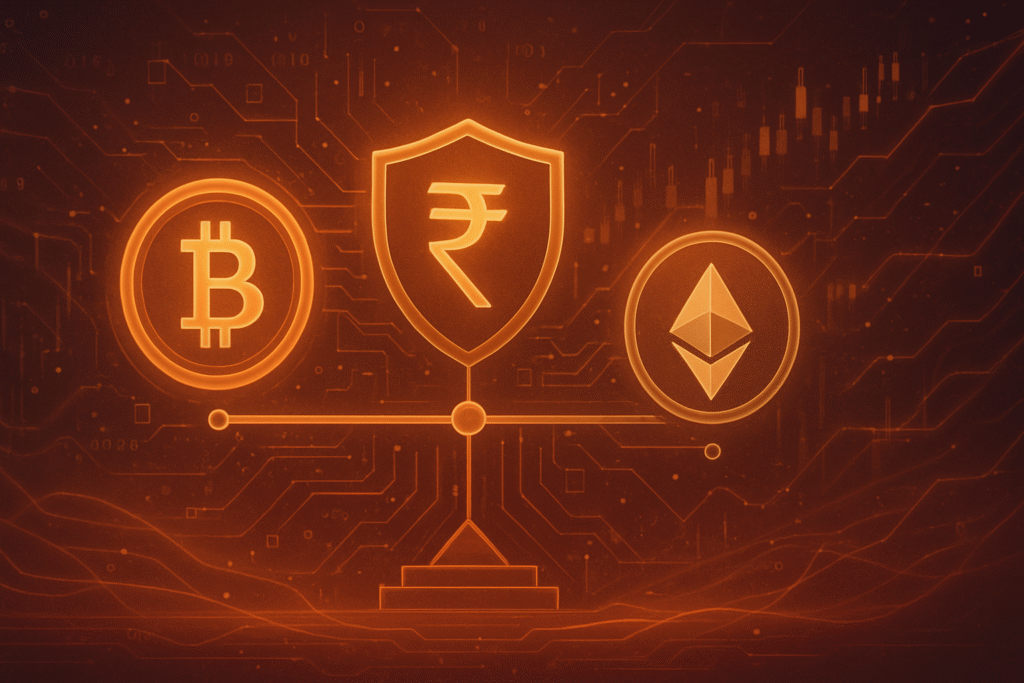
New Delhi, India – October 7, 2025 – India continues to navigate the complex waters of digital finance with a clear two-pronged strategy: maintaining a cautious, highly regulated approach to private cryptocurrency assets while aggressively pushing for the adoption and development of its central bank digital currency (CBDC), the Digital Rupee (e₹). This stance was recently underscored by Union Commerce Minister Piyush Goyal, who, speaking from Doha, Qatar, reiterated India's commitment to regulating rather than outright banning private digital assets, while simultaneously advising citizens against speculative investments in unbacked cryptocurrencies.
Minister Goyal's comments, made around October 6-7, 2025, emphasized that India cannot endorse cryptocurrencies lacking sovereign or asset backing, highlighting the stringent taxation and oversight in place to discourage their use. This sentiment reinforces the long-standing position of the Reserve Bank of India (RBI) regarding the inherent risks of private cryptos. Coming just days after Union Finance Minister Nirmala Sitharaman's nuanced statement on October 3, 2025, at the Kautilya Economic Conclave, where she acknowledged the inevitability of nations engaging with stablecoins, India's approach appears to be evolving, but still firmly rooted in control and sovereign backing. This dual narrative signals a maturing regulatory philosophy that seeks to harness the benefits of blockchain technology through the e₹, while mitigating the perceived risks of decentralized private assets.
Market Impact and Price Action
While specific, immediate price movements directly attributable to Minister Goyal's latest remarks are challenging to isolate in the broader global crypto market, India's consistent regulatory narrative undoubtedly contributes to a foundational sentiment. The continued emphasis on high taxation (30% on gains, 1% TDS) for Virtual Digital Assets (VDAs) acts as a persistent dampener on speculative trading within the country. This regulatory clarity, however restrictive, has arguably prevented the kind of wild market swings seen in other jurisdictions facing sudden, unexpected bans.
The market's reaction within India often manifests as a subdued trading environment for private cryptocurrencies on domestic exchanges. Volumes remain constrained compared to global counterparts, and liquidity is generally lower. While Bitcoin (BTC) and Ethereum (ETH) prices on Indian exchanges largely mirror international rates due to arbitrage, the significant tax burden erodes potential profits, making long-term holding and strategic investment more appealing than day trading. The absence of specific "affected tokens" in response to these general policy reiterations suggests that the market has largely priced in India's cautious stance. Instead, traders and investors are more attuned to global macroeconomic factors and major regulatory shifts from larger economies. The underlying technical analysis for major cryptocurrencies remains dictated by global trends, with India's domestic policies primarily influencing investor behavior and adoption rates rather than direct price action.
Community and Ecosystem Response
The Indian crypto community, accustomed to the government's cautious stance, largely views Minister Goyal's recent comments as a reinforcement of the status quo rather than a new development. Social media sentiment on platforms like Twitter and Reddit often reflects a mix of resignation and continued advocacy for a more progressive regulatory framework. Crypto influencers and thought leaders within India frequently call for clearer distinctions between different types of digital assets, arguing that a blanket approach fails to recognize the innovation potential of certain projects, especially those in the DeFi and Web3 space.
Reactions to Finance Minister Sitharaman's acknowledgment of stablecoins, however, sparked a glimmer of hope among some. This subtle shift suggests a potential future where certain asset-backed cryptocurrencies might receive a more favorable regulatory treatment, distinct from volatile, unbacked tokens. For related DeFi protocols, NFT projects, and Web3 applications, the challenge remains significant. Without clearer legal recognition and a more conducive tax environment, widespread adoption and institutional investment within India are hampered. Many Indian developers and entrepreneurs in the Web3 space often look to international markets for growth and funding, as the domestic regulatory uncertainty creates a difficult operating environment. The broader crypto Twitter and Reddit sentiment outside India often views the country as a market with immense potential but significant regulatory hurdles, with many watching closely for any signs of a more open approach.
What's Next for Crypto
The short-term implications for the Indian crypto market suggest a continuation of the current environment: high taxation, cautious trading, and a strong government push for the Digital Rupee. However, the long-term outlook might see a gradual, nuanced evolution. Finance Minister Sitharaman's comments on stablecoins could be a crucial catalyst. If India develops a framework to differentiate stablecoins from other private cryptocurrencies, it could unlock new avenues for adoption, particularly in cross-border payments and remittances, areas where the e₹ is also being targeted.
Potential developments to watch include the finalization and passage of a comprehensive cryptocurrency bill, which has been under discussion for years. Such a bill, if it provides clear definitions and a tiered regulatory approach, could bring much-needed certainty. Strategic considerations for projects and investors involve closely monitoring government whitepapers, RBI statements, and parliamentary discussions. Projects aiming to enter the Indian market would do well to align with the government's broader digital economy goals and explore use cases that complement, rather than directly compete with, the Digital Rupee. Possible scenarios range from a continued restrictive environment, with the e₹ gaining dominance, to a more open, albeit regulated, market for specific types of private digital assets. The latter scenario, while less likely in the immediate future, gains slightly more traction with recent ministerial acknowledgments of global crypto trends.
Bottom Line
For crypto investors and enthusiasts, the key takeaway from India's current stance is the emphasis on sovereign control and risk mitigation. While private crypto assets are not banned, they operate under a regime designed to discourage speculative activity and ensure traceability. The Indian government's unwavering commitment to the Digital Rupee (e₹), evidenced by successful pilot programs and expanding user bases (4.6 million customers and 400,000 businesses by April 2024), signals its belief in a sovereign-backed digital future. The e₹ is poised to become a significant player in India's financial landscape, offering a secure, efficient, and traceable alternative to both physical cash and potentially, private digital assets.
The long-term significance lies in India's ability to set a precedent for other developing nations grappling with similar regulatory challenges. Its approach of leveraging blockchain for a national CBDC while maintaining a tight leash on decentralized assets could become a model. Final thoughts suggest that while India's market for private cryptocurrencies may remain challenging, the country is undeniably a major player in the global digital finance narrative, largely through its ambitious CBDC project. Important metrics to monitor include the expansion of the e₹'s use cases, particularly in cross-border payments, and any further legislative clarity on the classification and regulation of different types of private digital assets, especially stablecoins.
This article is for informational purposes only and does not constitute financial or investment advice. Cryptocurrency investments carry significant risk.






